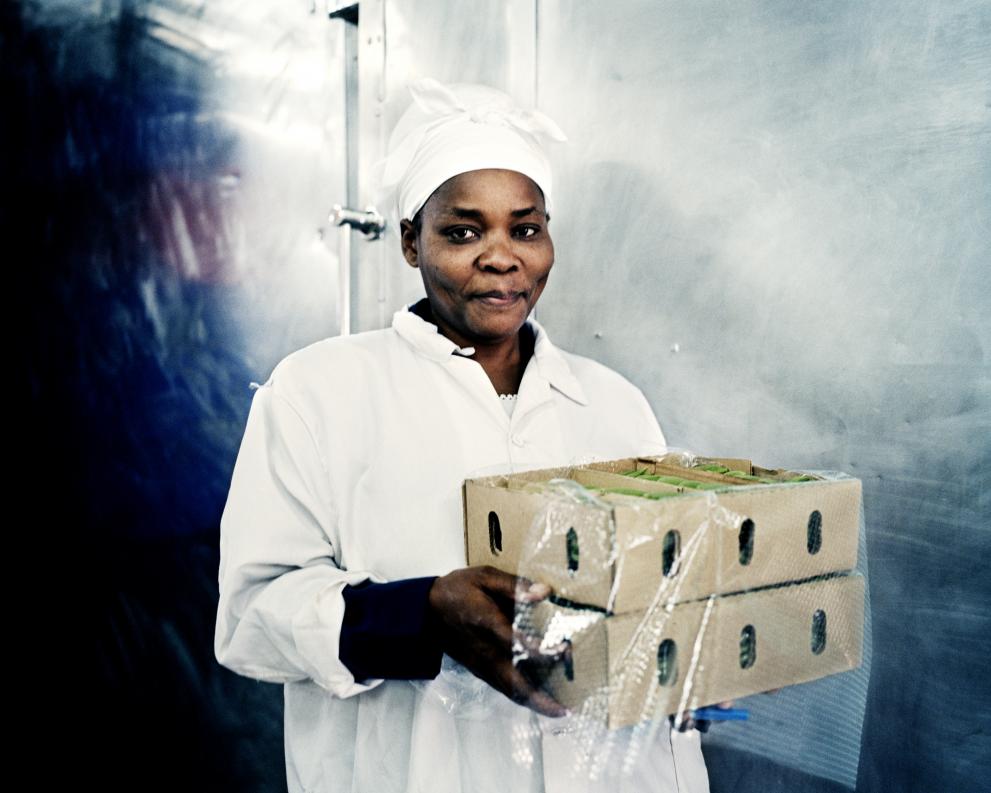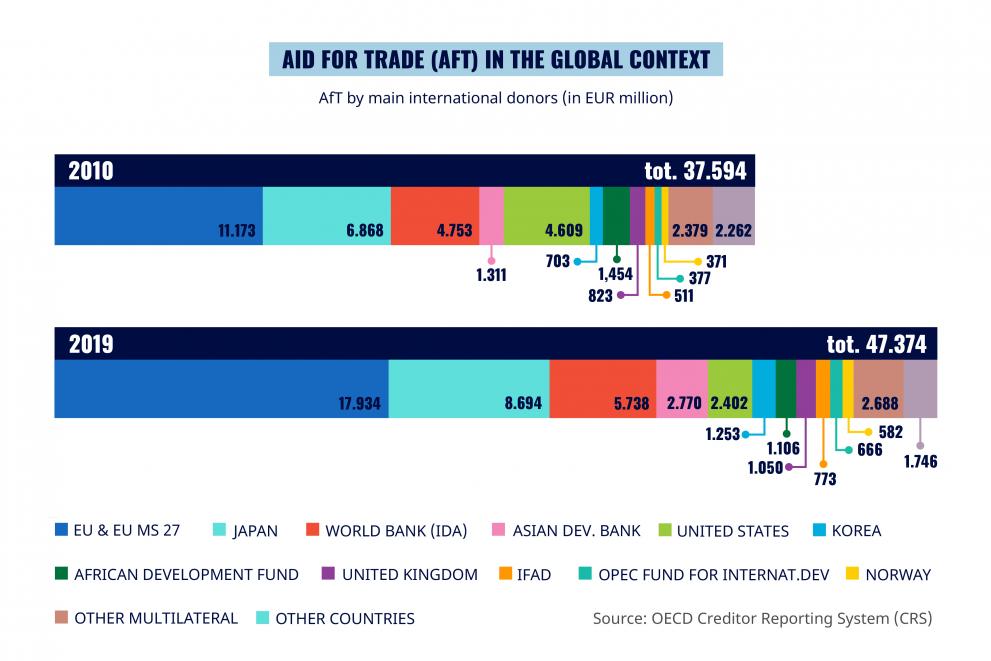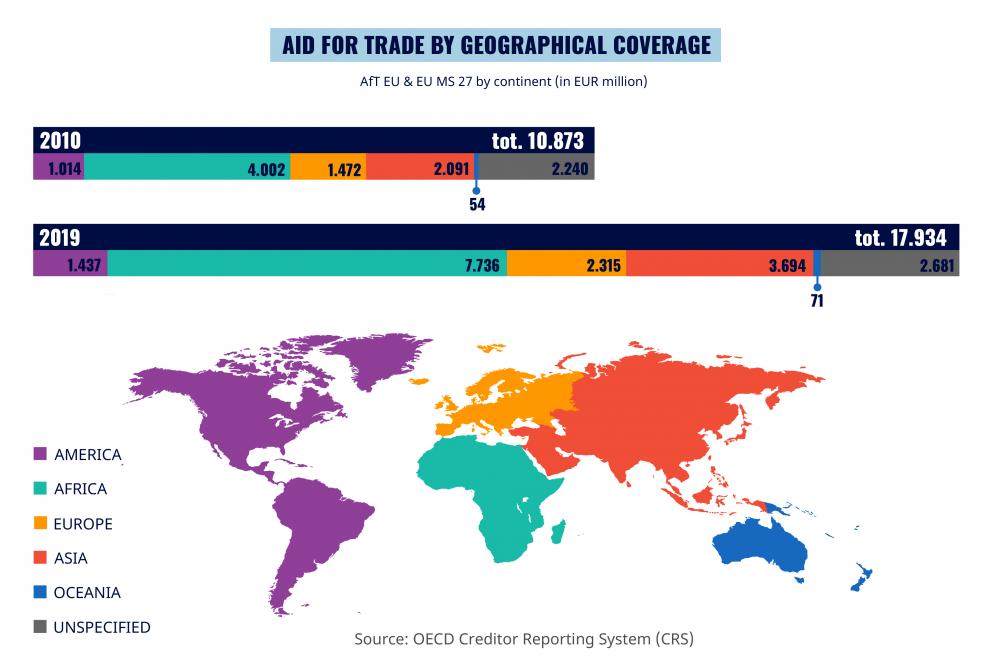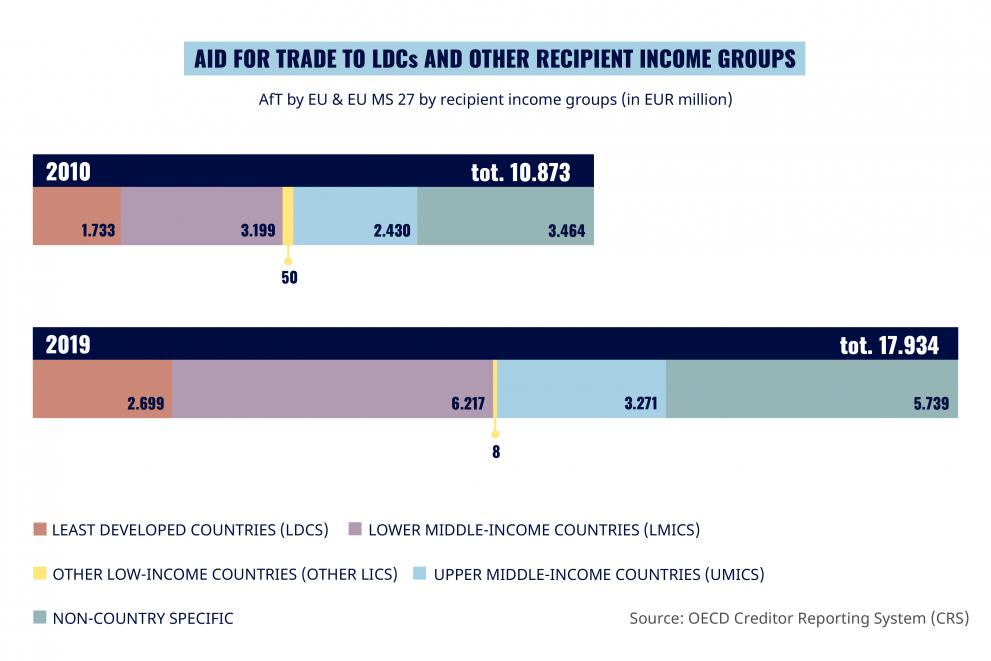Trade is essential for a country’s economic growth and development. EU partner countries often face internal constraints that prevent them from reaping the economic benefits of expanded trade. With Aid for Trade, the EU aims to support these countries in overcoming obstacles such as cumbersome regulations, poor infrastructure and lack of appropriate skills in order to better integrate and benefit from the global rules-based trading system.
The EU is a key partner for developing countries who are seeking to expand and strengthen their trade policies in a sustainable way.
Aid for Trade
Supporting the World Trade Organization (WTO) Aid for trade (AfT) initiative, the EU has become over time the leading provider of AfT (38% of global AfT).
The EU’s AfT strategy of 2017 considers the interlinkages that exist between investment and trade which need to be fully exploited to achieve the Sustainable Development Goals (SDGs), in line with the UN’s 2030 Agenda. The objectives of the EU AfT strategy are to:
- better align EU AfT interventions with market-driven opportunities and constraints
- focus more on least developed countries (LDCs) as they need the most support
- vary approach depending on country’s level of development
- use a variety of AfT instruments (grants, budget support, blending and guarantees, improving investment climate etc.)
- increase the contribution of AfT to SDGs while supporting a stronger participation of women in the economy

Our approach
To achieve these objectives and maximise development impact, a coherent mobilisation of our policy instruments is needed. These include technical assistance, capacity building, budget support, blending and guarantees.
EU trade instruments have become major drivers of our relationship with partner countries. Altogether, the EU provides preferential treatment to 126 countries eligible for EU official development assistance (ODA) - 54 through Free Trade Agreements in force and 72 through the Generalised Scheme of Preferences (GSP).
Advancing sustainability objectives
The EU Aid for Trade is focusing on results leading to a more inclusive and greener global economy. Fostering women’s economic empowerment and promoting low-carbon and climate-resilient economies as well as digitalisation are key areas in all EU external actions. Building inclusive, low-carbon and climate-resilient economies and protecting biodiversity are at the heart of the EU’s Aid for Trade.

EU AfT in 2019-2020: COVID-19 and Team Europe’s response
Due to COVID-19, progress towards the SDGs has slowed, with poverty increasing for the first time in 20 years. On average, the SDG funding gap in developing countries is projected to increase from €2.2. trillion pre-COVID to €3.7 trillion a year for the foreseeable future, a 70% increase. The impact of the global pandemic on trade has been dramatic. EU imports from developing countries declined by almost €100 billion (-16%) from €621.6 billion to €522.9 billion between 2019 and 2020.
Team Europe, i.e. the European Union and its Member States (with their development finance institutions and implementing agencies) as well as the European Investment Bank (EIB) and the European Bank for Reconstruction and Development (EBRD) acting together, reacted swiftly to counter the impact of COVID-19 on its partner developing countries, and mobilised resources of €46 billion, including re-oriented resources under several ongoing projects to better respond to the crisis as well as additional resources through fast track approvals.
In 2019, the EU and EU Member States’ commitments amounted to €17.9 billion, an increase of 12% in real terms compared to 2018. The EU and EU MS remain the leading AfT donor with 38% of global AfT.


Differentiation
Stemming from the 2017 updated Joint EU Strategy on Aid for Trade, the EU intends to increase the share of EU AfT allocated to Least Developed Countries - LDCs (currently 15% for EU and EU Member States 27 combined) to 25% by 2030 to help these countries double their share of global exports.
The EU is the world’s most open market for LDCs thanks to the ‘Everything but Arms’ scheme that removes tariffs and quotas for all imports of goods (except arms and ammunition), coming into the EU from least developed countries (LDCs).

AfT varying approaches
EU Aid for Trade is provided through varying approaches that take into consideration the different needs based on the level of income. In LDCs EU AfT is more concentrated on agriculture, accounting for 34% of all cumulative commitments over the period 2010-2019, compared to 10% for lower-middle income countries (LMIC) and 8% for upper-middle-income countries (UMIC).
EU Aid for Trade in LMICs is more concentrated on energy infrastructure (44% for 2010-2019), while EU AfT for transport infrastructure is similar among the 3 income groups (between 21 and 24%).
EU Aid for Trade in UMICs is more concentrated on banking and financial services that received (26% between 2010-2019), and building non-trade development related productive capacity, with a share of 37% of all commitments.
Blending and investment for trade
The EU continues to provide AfT through its guarantees and blending operations (‘blending’ means a combination of EU grants with loans or equity from public and private financiers). In line with blending, the European Fund for Sustainable Development (EFSD) has introduced a paradigm shift towards leverage-based development aid with our partner countries in Africa and the EU neighbourhood, and provides the framework for massive mobilisation of private investments. During 2020, the EU provided guarantees and blending for a total of €1.8 billion, leveraging resources of over €10 billion, two thirds of which are in Africa and the Neighbourhood countries.
Thematic areas
EU Aid for Trade supports also regional integration through multi-country programmes focusing on the negotiation and implementation of regional trade agreements and on support to key regional value chains. In particular, between 2014 and 2020 the EU has been supporting the African Continental Free Trade Area (AfCFTA) through its Pan-African Programme with more than €74 million. At a multi-country level, the EU has been supporting negotiation and implementation of Economic Partnership Agreements (EPAand i-EPA) provisions, with a total amount of €86 million between 2014 and 2020.
The effort by Team Europe in supporting improvements in the regulatory environment for the private sector has been consistent, with the EU providing about €1 billion per year for private-sector-development (PSD) sector budget support.
EU trade facilitation assistance which supports the WTO Facilitation Agreement implementation targets provisions of the TFA for which partner countries require assistance.
Digital technologies are also being factored into EU AfT, both as an emerging sector and an enabling tool to promote growth, entrepreneurship and job creation. The launch of the Digital for Development (D4D) Hub is an example of a global multi-stakeholder platform that marks a turning point in the EU’s international partnerships to support a human-centric digital transformation. The D4D Hub bundles the multitude of digital initiatives by European actors for unparalleled coordinated impact.
Related documents
- 8 MARCH 2022
- 8 MARCH 2022
- 8 MARCH 2022
- 8 MARCH 2022
- 8 MARCH 2022
- 8 MARCH 2022
- 8 MARCH 2022
Useful links
World Trade Organization (WTO) - Aid for Trade
